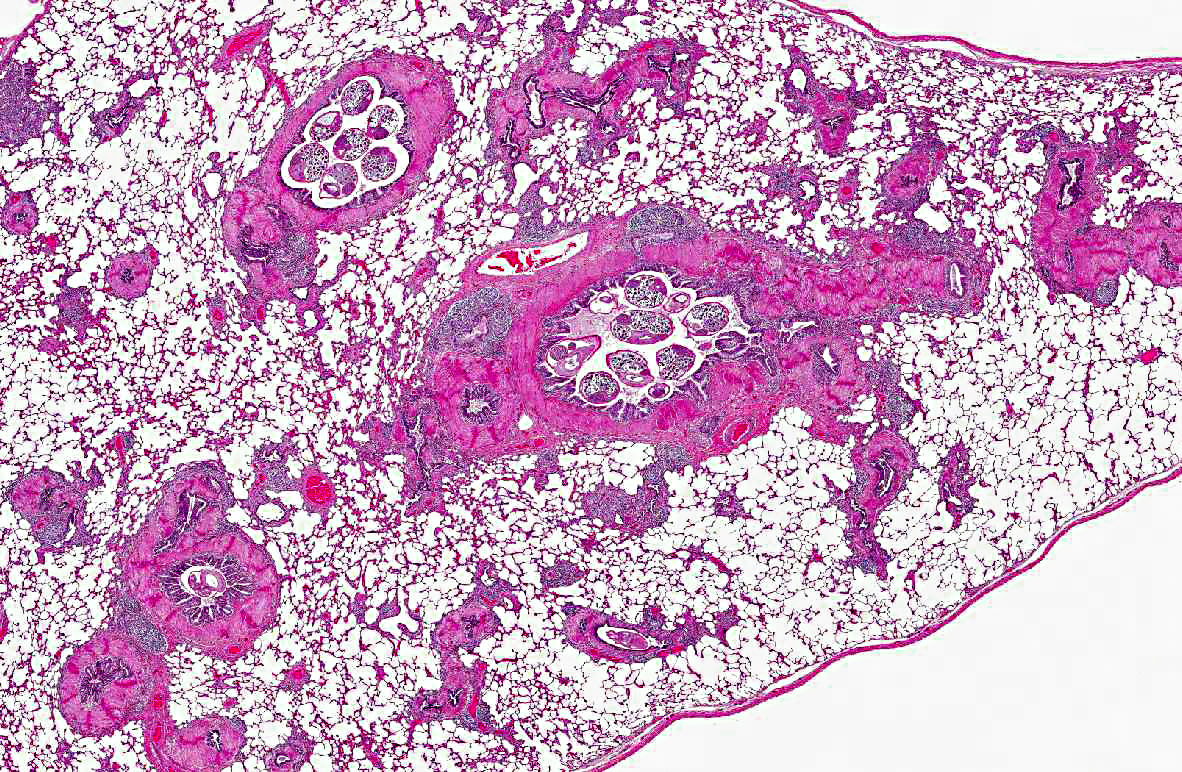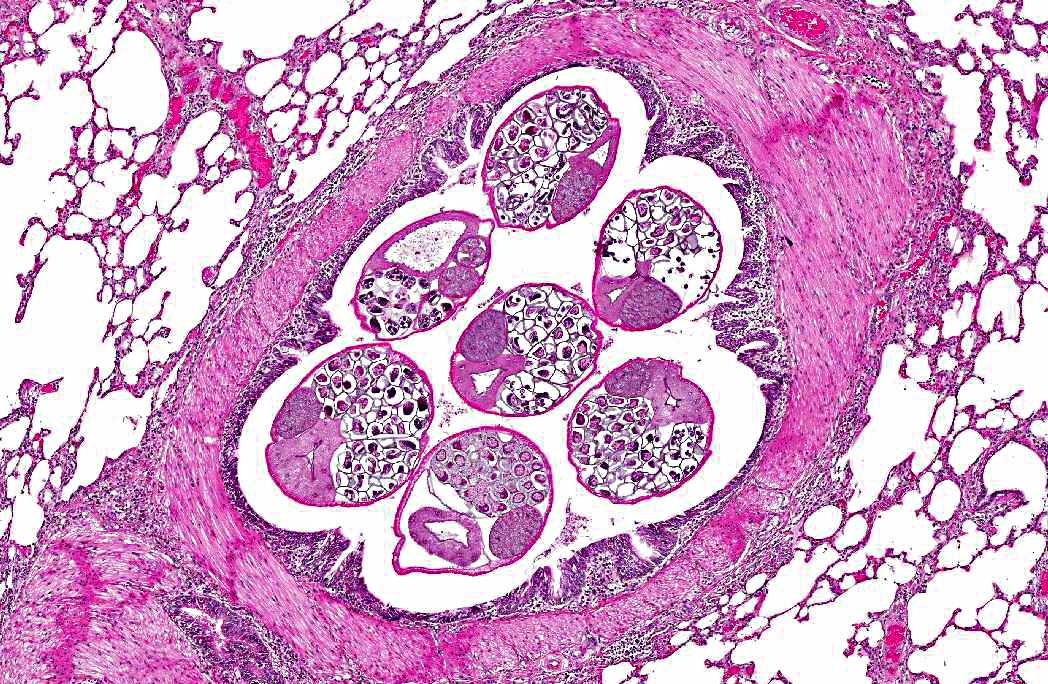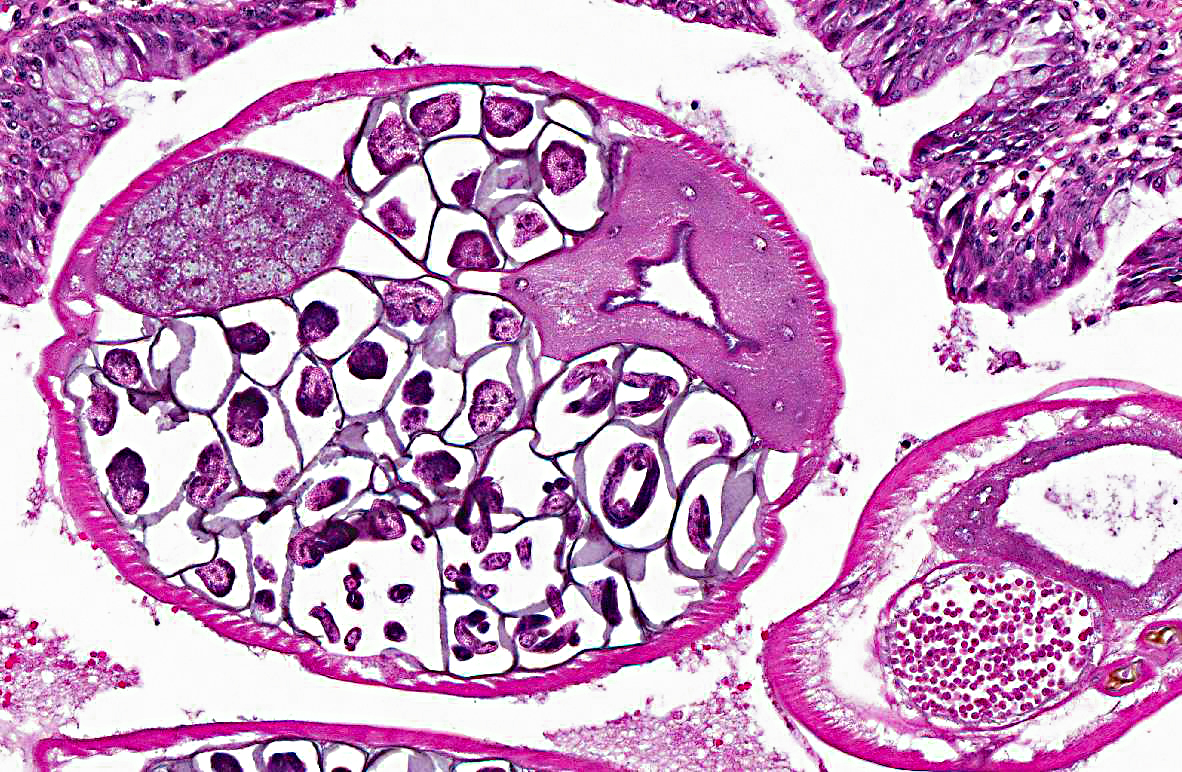Signalment:
6- to 8-month old, female feral pig,
Sus scrofa, porcine.This pig was trapped and killed as part of a feral swine monitoring project.
Gross Description:
A female, black, wild hog in good body condition (BCS 6/9) was presented for necropsy. Numerous live ticks were present on the surface of the body. A 2 cm bullet hole was present caudal to the right eye. Coagulated blood was in the oral cavity. Pink froth was in the lumen of the trachea and extended to the larynx (pulmonary edema). The lungs were diffusely reddened with only approximately 5 cm x 2 cm areas of normal pink lung tissue at the distal poles of the caudal lung lobes. The lung contained large coalescing areas of depressions. The bronchioles of both caudal lung lobes contained numerous white nematodes that were 4-6 cm in length (
Metastrongylus sp.). The brain contained multifocal areas of hemorrhage (status post brain trauma induced by euthanasia).
Histopathologic Description:
Lung. Bronchi and bronchioles contain intraluminal nematodes that are 500-700 micrometers in diameter, with a thin cuticle surrounding a body cavity with coelomyarian musculature, an intestinal tract lined by few multinucleated cells, ovaries, and uteri filled with oocytes and developing larva. The eggs are occasionally free in the lumen of bronchi. There are small to moderate amounts of intraluminal edema, fibrin and mucus admixed with eosinophils and few macrophages, lymphocytes, plasma cells and neutrophils. The bronchial and bronchiolar epithelium is hyperplastic with goblet cell metaplasia and occasionally forms outpouchings. There is marked peribronchial and peribronchiolar smooth muscle hypertrophy. Bronchi and bronchioles are surrounded by moderate to numerous eosinophils with lesser numbers of lymphocytes and plasma cells. There is bronchial associated lymphoid tissue (BALT) hyperplasia. There are multifocal to coalescing areas of alveolar capillary congestion with associated intra-alveolar edema.Â
Morphologic Diagnosis:
Lung: Moderate multifocal eosinophilic pneumonia with smooth muscle hypertrophy, goblet cell metaplasia, BALT hyperplasia and numerous intrabronchial and intrabronchiolar nematodes, consistent with
Metastrongylus sp.
Condition:
Pulmonary metastrongyliasis
Contributor Comment:
Metastrongylus sp. is the common lung nematode that is parasitic in the bronchi and bronchioles of the pig.Â
M. apri is the most common, but other species include
M. pudendotectus, and
M. salmi.(1) They are nematodes of the superfamily
Metastrongyloidea and the family
Protostrongylidae. The intermediate host is the earthworm, and the infective third stage larvae may survive in the earthworm for as long as 18 months. Once the intermediate host is ingested, the larvae migrate through the lymphatics from the intestine to the lungs. Some larvae pass through the liver, producing focal hepatitis, as seen with Ascaris suum larval migration. The prepatant period for
Mestastrongylus sp. is approximately 25 days after which there is a rapid rate of egg production, which eventually subsides to a low level.Â
Clinical signs include persistent cough, which may be paroxysmal, and growth retardation of the host-�-�which can have a significant negative economic impact in domestic swine.(2) When noticeable, gross lesions typically consist of gray nodules on the pleural surface of the lung, and adult nematodes which can be visualized in bronchi and bronchioles. Heavy pulmonary infections are usually in younger pigs, where worms may be found in all lung lobes. Whereas in older animals, there are typically fewer worms that are often restricted to airways along the caudoventral borders of the caudal lung lobes. Because the earthworm is the intermediate host, pulmonary metastrongylosis is common in wild pigs, but is rare in housed domestic swine. Lungworms are considered to play a role in the transmission of swine influenza.
JPC Diagnosis:
Bronchiolitis, eosinophilic and lymphohistiocytic, diffuse, mild, with marked smooth muscle hyperplasia, BALT hyperplasia and numerous cross sections of adult metastrongyles.Â
Conference Comment:
The contributor provided a good summary of metastrongylosis in swine, as well as excellent specimens that allow easy visualization of many of the characteristics of
Metastrongylus species. In addition to the genus
Metastrongylus, phylum
Nematoda contains numerous parasitic species that are of concern in veterinary medicine. When evaluating nematodes in tissue section, it is important to note and describe several key characteristics in a consistent and organized format, paying particular attention to any diagnostically salient features, some of which allow for the diagnosis of a nematode and some of which allow further identification to genus and perhaps even species. A description of important features of nematodes, and specifically metastrongyles, follows. Nematodes have a cuticle that can vary in thickness from barely discernible to very thick and may be smooth or adorned with bumps, ridges, or wing-like structures. Internal to the cuticle is the hypodermis. In phasmid nematodes such as metastrongyles, lateral extensions of the hypodermis (lateral chords), and dorsal and ventral nerve chords protrude into the pseudocoelom (body cavity), dividing it into quadrants. Additionally, metastrongyles also have accessory hypodermal chords that further subdivide the quadrants. Lateral chords may protrude deeply into the pseudocoelom, or may be low and flat. The hypodermis of phasmid nematodes contains very few nuclei except in the lateral chords. Internal to the hypodermis, nematodes have somatic musculature which either projects into the pseudocoelom in a cylinder-like manner (coelomyarian), or lies low and flat on the hypodermis (platymyarian). Coelomyarian muscle arrangement is such that numerous muscle cells can be present in a single cross section (polymyarian). Conversely, platymyarian muscles are generally larger and fewer (meromyarian). Metastronglyes differ from other members of the strongyle group (i.e. true strongyles and trichostrongyles) by having coelomyarian musculature. Another important feature of nematodes is their digestive tract, which is composed of a mouth, buccal cavity, esophagus, intestine and anus. Esophagus and intestine shape and composition can be useful in identification. Intestines are large, medium or small (described relative to the size of the nematode), and are lined by either many cuboidal to columnar cells, or few multinucleate cells. A brush border of microvilli may be present. Metastrongyles, like other strongyles, have a large intestine lined by few multinucleate cells. Lastly, adult nematodes also have reproductive tracts. In phasmid nematodes, the female has two or more reproductive tracts composed of ovaries, oviducts and uteri. Uteri contain developing eggs or embryos, the presence of which is another identifying feature, as eggs vary among and within groups. Eggs can contain zygotes or larvae; they can be thin- or thick -shelled, or, as in the case of metastrongyle larvae, the shell can be so thin it is not discernible. Metastrongyle larvae have more structure than other nematode larva, which often appear as a sac of nuclei; metastrongyle larvae have a primitive alimentary tract, as well as eccentric tail tips and, in some genera, caudal spines. Adult male nematodes have only one reproductive tract. The testis produces sperm which can be seen in the vas deferens. Sperm can also be found in the female, as the distal part of the uteri (seminal receptacle) stores sperm from previous copulations.(3)
References:
1. Pence DB, Warren RJ, Ford CR. Visceral helminth communities of an insular population of feral swine.Â
J Wildl Dis. 1988;24(1): 105-112.
2. Kahn, CM., ed.Â
The Merck Veterinary Manual. 9th ed. Whitehouse Station, NJ: Merck & Co., Inc.; 2005:1181-1184.
3. Gardiner CH, Poynton SL.Â
An Atlas of Metazoan Parasites in Animal Tissues. Washington, DC: Armed Forces Institute of Pathology/ American Registry of Pathology; 2006:2-29.


